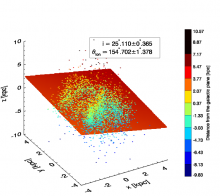
Abstract
We determine the geometrical and viewing angle parameters of the Large Magellanic Cloud (LMC) using the Leavitt law based on a sample of more than 3500 common classical Cepheids (FU and FO) in optical (V,I), near-infrared (JHKs) and mid-infrared ([3.6] μm and [4.5] μm) photometric bands. Statistical reddening and distance modulus free from the effect of reddening to each of the individual Cepheids are obtained using the simultaneous multi-band fit to the apparent distance moduli from the analysis of the resulting Leavitt laws in these seven photometric bands. A reddening map of the LMC obtained from the analysis shows good agreement with the other maps available in the literature. Extinction free distance measurements along with the information of the equatorial coordinates (α,δ) for individual stars are used to obtain the corresponding Cartesian coordinates with respect to the plane of the sky. By fitting a plane solution of the form z=f(x,y) to the observed three dimensional distribution, the following viewing angle parameters of the LMC are obtained: inclination angle i=25∘.110±0∘.365, position angle of line of nodes θlon=154∘.702±1∘.378. On the other hand, modelling the observed three dimensional distribution of the Cepheids as a triaxial ellipsoid, the following values of the geometrical axes ratios of the LMC are obtained: 1.000±0.003:1.151±0.003:1.890±0.014 with the viewing angle parameters: inclination angle of i=11∘.920±0∘.315 with respect to the longest axis from the line of sight and position angle of line of nodes θlon=128∘.871±0∘.569. The position angles are measured eastwards from north.